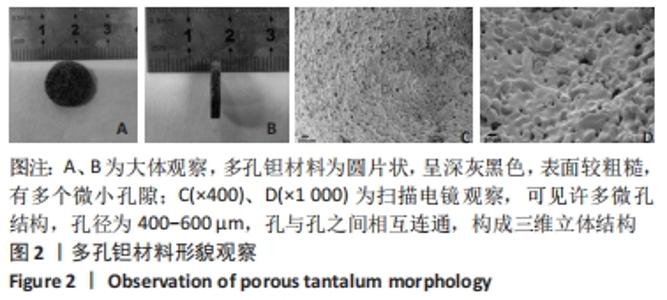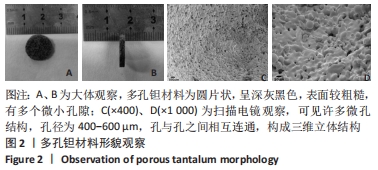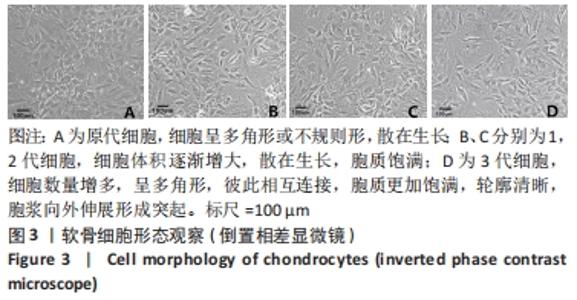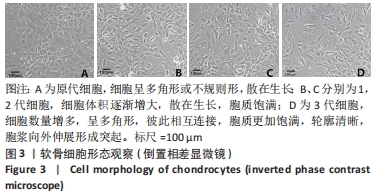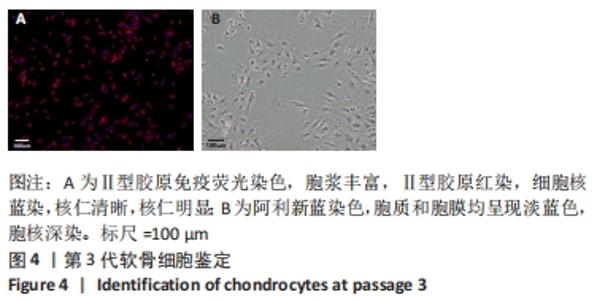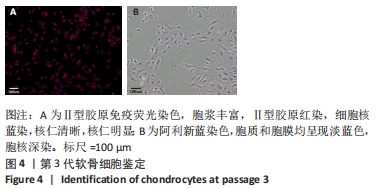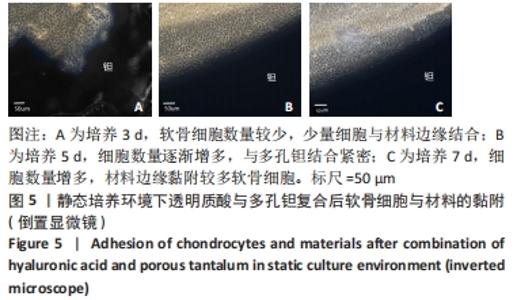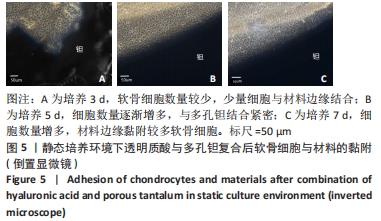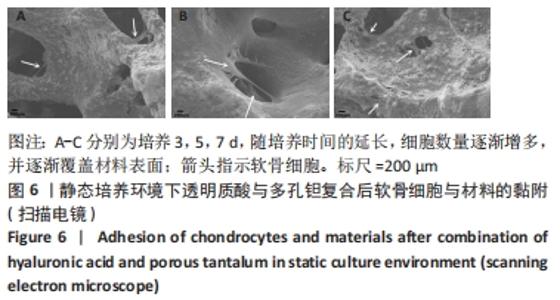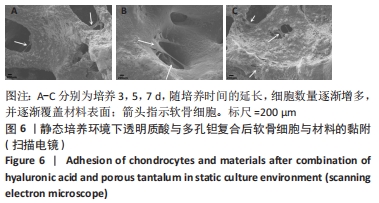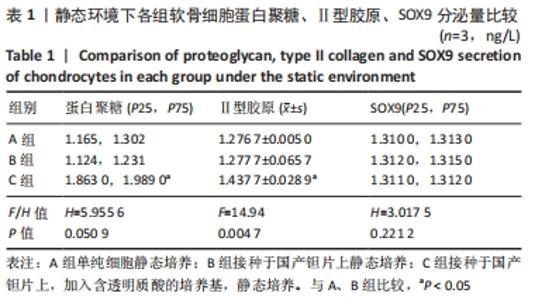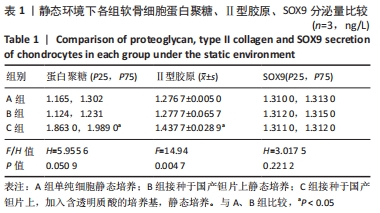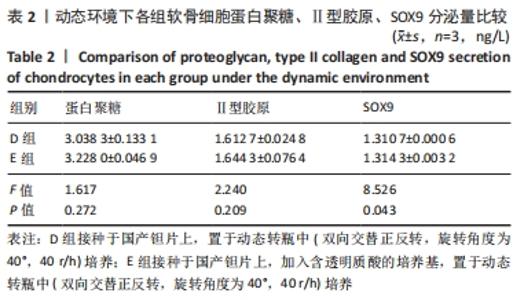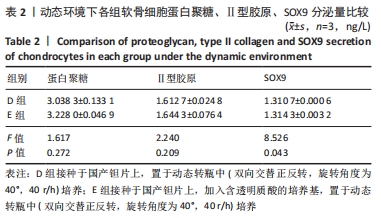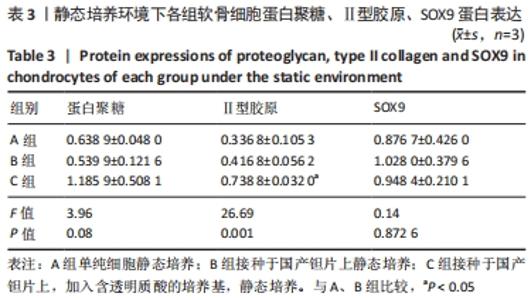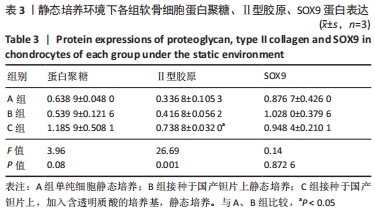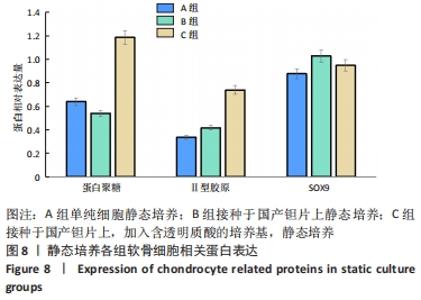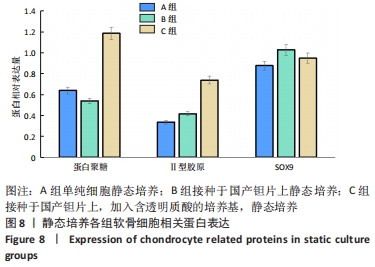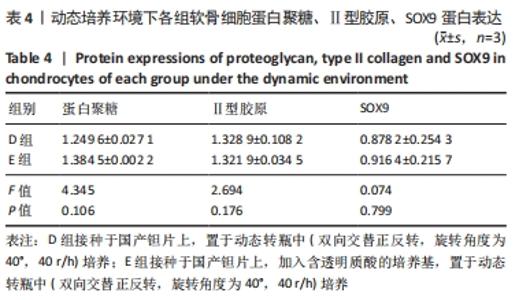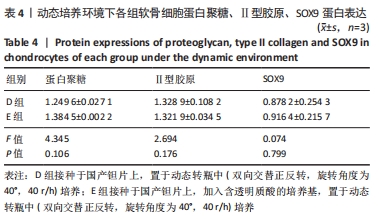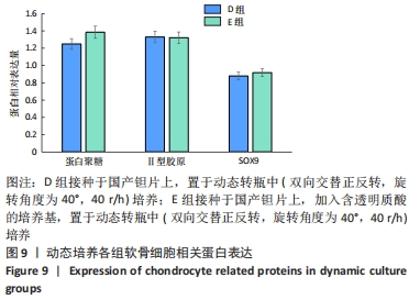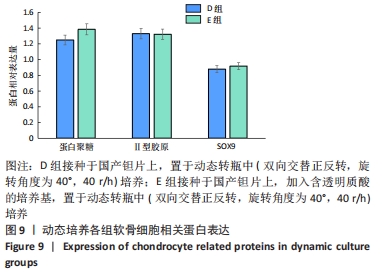Chinese Journal of Tissue Engineering Research ›› 2023, Vol. 27 ›› Issue (3): 339-345.doi: 10.12307/2023.025
Previous Articles Next Articles
Effects of hyaluronic acid combined with domestic porous tantalum on chondrocyte function under the dynamic environment
Zhang Hui1, Wang Jiayang2, Wang Qian3, 4, Gan Hongquan2, Wang Zhiqiang2
- 1First Department of Joint Surgery, Second Hospital of Tangshan, Tangshan 063000, Hebei Province, China; 2Department of Orthopedics, Affiliated Hospital of North China University of Science and Technology, Tangshan 063000, Hebei Province, China; 3School of Clinical Medicine, North China University of Science and Technology, Tangshan 063000, Hebei Province, China; 4Hebei Key Laboratory of Medical Engineering Integration Precision Medicine, Tangshan 063000, Hebei Province, China
-
Received:2021-09-22Accepted:2022-01-13Online:2023-01-28Published:2022-05-19 -
Contact:Wang Qian, MD, Associate professor, Master’s supervisor, School of Clinical Medicine, North China University of Science and Technology, Tangshan 063000, Hebei Province, China; Hebei Key Laboratory of Medical Engineering Integration Precision Medicine, Tangshan 063000, Hebei Province, China -
About author:Zhang Hui, MD, Associate chief physician, First Department of Joint Surgery, Second Hospital of Tangshan, Tangshan 063000, Hebei Province, China -
Supported by:Science and Technology Support Project Funded by the Ministry of Science and Technology, No. 2012BAE06B03 (to WZQ); Hebei Provincial Medical Science Research Key Project Funding Project, No. 20160225 (to WZQ); Hebei Provincial Health and Family Planning Commission Funded Project, No. 20180733 (to WQ)
CLC Number:
Cite this article
Zhang Hui, Wang Jiayang, Wang Qian, Gan Hongquan, Wang Zhiqiang. Effects of hyaluronic acid combined with domestic porous tantalum on chondrocyte function under the dynamic environment[J]. Chinese Journal of Tissue Engineering Research, 2023, 27(3): 339-345.
share this article
Add to citation manager EndNote|Reference Manager|ProCite|BibTeX|RefWorks
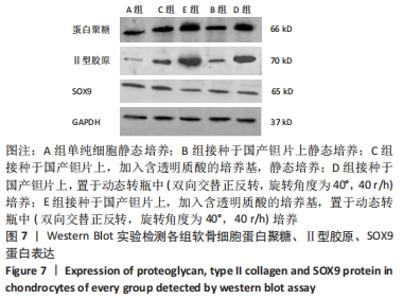
静态与动态培养环境下的蛋白聚糖、Ⅱ型胶原分泌量比较差异均有显著性意义(F=1041,P=0.000;F=76.221,P=0.000),B组蛋白聚糖、Ⅱ型胶原分泌量低于D组(P < 0.05),C组蛋白聚糖、Ⅱ型胶原分泌量低于E组(P < 0.05);静态与动态培养环境下的SOX9分泌量比较差异无显著性意义(F=0.023,P=0.883)。 透明质酸对3因子影响明显,透明质酸复合前后蛋白聚糖(F=92.881,P=0.000)、Ⅱ型胶原(F=9.565,P=0.015)、SOX9(F=6.721,P=0.032)分泌量比较差异均有显著性意义(P < 0.05)。 2.6 各组软骨细胞蛋白聚糖、Ⅱ型胶原、SOX9蛋白表达量 见图7。 "
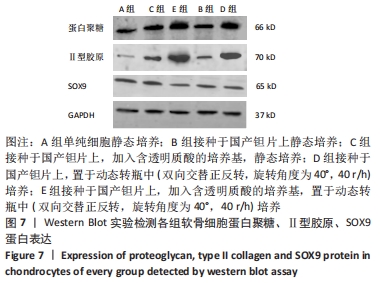

静态与动态培养环境下的蛋白聚糖、Ⅱ型胶原蛋白表达量比较差异均有显著性意义(F=9.045,P=0.017;F=392.689,P=0.000),D组蛋白聚糖、Ⅱ型胶原蛋白表达量高于B组(P < 0.05),E组蛋白聚糖、Ⅱ型胶原蛋白表达量高于C组(P < 0.05);静态与动态培养环境下的SOX9蛋白表达量比较差异无显著性意义(F=0.331,P=0.581)。 透明质酸对3因子蛋白表达量影响明显,透明质酸复合前后蛋白聚糖(F=6.683,P=0.032)、Ⅱ型胶原(F=17.422,P=0.003)、SOX9(F=5.721,P=0.043)蛋白表达量比较差异均有显著性意义(P < 0.05)。 "

| [1] HUBBARD MJ. Articular debridement versus washout for degeneration of the medial femoral condyle. A five-year study. Bone Joint Surg Br. 1996;78(2):217-219. [2] JACKSON RW, DIETERICHS C. The results of arthroscopic lavage and debridement of osteoarthritic knees based on the severity of degeneration: a 4- to 6-year symptomatic follow-up. Arthroscopy. 2003;19(1):13-20. [3] PAP T, KORB-PAP A. Cartilage damage in osteoarthritis and rheumatoid arthritis-two unequal siblings. Nat Rev Rheumatol. 2015;11(10): 606-615. [4] CHIANG H, KUO TF, TSAI CC, et al. Repair of porcine articular cartilage defect with autologous chondrocyte transplantation. J Orthop Res. 2005;23(3):584-593. [5] JAMIL K, CHUA KH, JOUDI S, et al. Development of a cartilage composite utilizing porous tantalum, fibrin, and rabbit chondrocytes for treatment of cartilage defect. J Orthop Surg Res. 2015;7(10):27. [6] YAZDIMAMAGHANI M, RAZAVI M, VASHAEE D, et al. Porous magnesium-based scaffolds for tissue engineering. Mater Sci Eng C Mater Biol Appl. 2017;1(71):1253-1266. [7] LIU Y, SU X, ZHOU S, et al. A modified porous tantalum implant technique for osteonecrosis of the femoral head: survivorship analysis and prognostic factors for radiographic progression and conversion to total hip arthroplasty. Int J Clin Exp Med. 2015;8(2):1918-1930. [8] KHAN FA, ROSE PS, YANAGISAWA M, et al. Surgical Technique: Porous Tantalum Reconstruction for Destructive Nonprimary Periacetabular Tumors. Clin Orthop Relat Res. 2012;470(2):594-601. [9] PATIL N, LEE K, GOODMAN SB. Porous Tantalum in Hip and Knee Reconstructive Surgery. J Biomed Mater Res B Appl Biomater. 2009; 89(1):242-251. [10] SALWOWSKA NM, BEBENEK KA, ŻĄDŁO DA, et al. Physiochemical properties and application of hyaluronic acid: a systematic review. J Cosmet Dermatol. 2016;15(4):520-526. [11] OZKAN FU, OZKAN K, RAMADAN S, et al. Chondroprotective effect of N-acetylglucosamine and hyaluronate in early stages of osteoarthritis-an experimental study in rabbits. Bull NYU Hosp Jt Dis. 2009;67(3):352-357. [12] MUJEEB A, MILLER AF, SAIANI A, et al. Self-assembled octapeptide scaffolds for in vitro chondrocyte culture. Acta Biomater. 2013;9(1): 4609-4617. [13] ALAVI A, STUPACK DG. Cell survival in a three-dimensional matrix. Methods Enzymol. 2007;426:85-101. [14] 郑欣欣,曹贵方.浅谈动物细胞体外三维培养技术[J].内蒙古科技与经济,2015(19):89-90. [15] 张振,罗辉宇,曾炼.大鼠软骨细胞与兔软骨细胞的培养与比较[J].骨科,2020,11(4):323-328. [16] 张辉,王少华,王茜,等. RGD多肽修饰多孔钽可激活MG63细胞整合素/黏着斑激酶信号通路[J].中国组织工程研究,2021,25(16): 2535-2540. [17] 崔逸爽,赖振权,胡中岭,等. 骨形态发生蛋白7复合国产多孔钽对骨髓间充质干细胞向软骨分化及功能的影响[J].中国组织工程研究,2020,24(16):2478-2484. [18] SUN X, YIN H, WANG Y, et al.In Situ Articular Cartilage Regeneration through Endogenous Reparative Cell Homing using a Functional Bone Marrow-specific Scaffolding System. ACS Appl Mater Interfaces. 2018;10(45):38715-38728. [19] 吴昊,李朝旭.关节软骨损伤修复的治疗进展[J].世界最新医学信息文摘,2019,19(93):75-77. [20] 尤奇,段小军,杨柳,等.临床应用软骨组织工程技术修复关节软骨缺损的进展[J].实用骨科杂志,2018,24(1):52-55. [21] DI LUCA A, LONGONI A, CRISCENTI G, et al.Surface energy and stiffness discrete gradients in additive manufactured scaffolds for osteochondral regeneration. Biofabrication. 2016;8(1):015014. [22] YU X, QIAN G, CHEN S, et al. A tracheal scaffold of gelatin-chondroitin sulfate-hyaluronan-polyvinyl alcohol with orientated porous structure. Carbohydr Polym. 2017;159:20-28. [23] 张辉,李亮,王茜,等.骨形成蛋白-7对多孔钽/软骨细胞复合物分泌功能以及Col-Ⅱ, AGG和Sox9基因表达的影响[J].北京大学学报(医学版),2015,47(2):219-225. [24] WANG Q, ZHANG H, LI Q, et al. Biocompatibility and osteogenic properties of porous tantalum. Exp Ther Med. 2015;9(3):780-786. [25] MARDONES RM, REINHOLZ GG, FITZSIMMONS JS, et al. Development of a biologic prosthetic composite for cartilage repair. Tissue Eng. 2005; 11(9-10):1368-1378. [26] HEMSHEKHAR M, THUSHARA RM, CHANDRANAYAKA S, et al. Emerging roles of hyaluronic acid bioscaffolds in tissue engineering and regenerative medicine. Int J Biol Macromol. 2016;86:917-928. [27] ORYAN A, KAMALI A, MOSHIRI A, et al. Chemical crosslinking of biopolymeric scaffolds: Current knowledge and future directions of crosslinked engineered bone scaffolds. Int J Biol Macromol. 2018;107: 678-688. [28] JUHÁSZ ML, MARMUR ES. Temporal fossa defects: techniques for injecting hyaluronic acid filler and complications after hyaluronic acid filler injection. J Cosmet Dermatol. 2015;14(3):254-259. [29] SILVA CR, BABO PS, GULINO M, et al. Injectable and tunable hyaluronic acid hydrogels releasing chemotactic and angiogenic growth factors for endodontic regeneration. Acta Biomater. 2018;77:155-171. [30] MARTÍNEZ-SANZ E, OSSIPOV DA, HILBORN J, et al. Bone reservoir: Injectable hyaluronic acid hydrogel for minimal invasive bone augmentation. J Control Release. 2011;152(2):232-240. [31] 沈雁,唐毅,李斯明,等.碱性成纤维细胞生长因子与透明质酸对培养兔软骨细胞的作用[J].中华创伤杂志,2000,16(6):337-339. [32] 黄建荣,李卫平,沈慧勇.胰岛素样生长因子I与透明质酸对人关节软骨细胞的作用[J].中华生物医学工程杂志,2008,14(3):180-184. [33] 拉希德,刘世清.透明质酸对体外培养大鼠退变关节软骨细胞的影响[J].武汉大学学报(医学版),2007,28(2):177-180. [34] 杜国辉,屈爱存,陈建英,等.透明质酸对关节软骨蛋白聚糖aggrecan的影响[J].中国生化药物杂志,2011(2):45-47. [35] 高宗强,郭雄,陈君长,等.透明质酸对体外培养大骨节病软骨细胞Ⅱ型胶原和聚集蛋白聚糖mRNA表达的影响[J].中国组织工程研究,2009,13(46):9061-9065. [36] MUJEEB A, MILLER AF, SAIANI A, et al. Self-assembled octapeptide scaffolds for in vitro chondrocyte culture. Acta Biomater. 2013;9(1): 4609-4617. [37] 曲鹏玮,亓建洪,韩运宁,等.力学刺激对体外保存软骨活力影响的实验研究[J].中国医药生物技术,2018,13(3):243-248. [38] FITZGERALD JB, JIN M, DEAN D, et al. Mechanical Compression of Cartilage Explants Induces Multiple Time-dependent Gene Expression Patterns and Involves Intracellular Calcium and Cyclic AMP. J Biol Chem. 2004;279(19):19502-19511. [39] SHIEH AC, ATHANASIOU KA. Dynamic compression of single cells. Osteoarthritis Cartilage. 2007;15(3):328-334. [40] WALDMAN SD, SPITERI CG, GRYNPAS MD, et al. Effect of Biomechanical Conditioning on Cartilaginous Tissue Formation in Vitr. J Bone Joint Surg Am. 2003;2(1):101-105. [41] CHEN C, TAMBE DT, DENG L, et al. Biomechanical properties and mechanobiology of the articular chondrocyte. Am J Physiol Cell Physiol. 2013;305(12):C1202-C1208. [42] TOYODA T, SEEDHOM BB, KIRKHAM J, et al. Upregulation of aggrecan and type II collagen mRNA expression in bovine chondrocytes by the application of hydrostatic pressure. Biorheology. 2003;40:79-85. [43] JEON JE, SCHROBBACK K, HUTMACHER DW, et al. Dynamic compression improves biosynthesis of human zonal chondrocytes from osteoarthritis patients. Osteoarthritis Cartilage. 2012;20(8):906-915. |
| [1] | Mo Jun, Luo Zongping. Effects of static traction on the nucleus pulposus and annulus fibrosus of the rat intervertebral disc [J]. Chinese Journal of Tissue Engineering Research, 2024, 28(8): 1180-1185. |
| [2] | Li Jiaqi, Huang Yuanli, Li Yan, Wang Chunren, Han Qianqian. Mechanism and influencing factors in molecular weight degradation of non-cross-linked hyaluronic acid [J]. Chinese Journal of Tissue Engineering Research, 2024, 28(5): 747-752. |
| [3] | Jia Xiaofei, Ran Li, Ma Xiaoshuang, Hei Xiaoyan, Liu Jiani, Yang Nan, Ma Haibin, Chang Jingpeng. Regulation of chondrocyte autophagy by acupotomy to promote chondrocyte homeostasis in osteoarthritis [J]. Chinese Journal of Tissue Engineering Research, 2024, 28(34): 5452-5457. |
| [4] | Lu Mengya, Wu Xian, She Zeyu, Xia Shuai, Lu Man, Yang Yonghui. Acupotomy prevents knee osteoarthritis in rats by modulating chondrocyte apoptosis in the mitochondrial pathway [J]. Chinese Journal of Tissue Engineering Research, 2024, 28(32): 5190-5195. |
| [5] | Lin Feng, Cheng Ling, Gao Yong, Zhou Jianye, Shang Qingqing. Hyaluronic acid hydrogel-encapsulated bone marrow mesenchymal stem cells promote cardiac function in myocardial infarction rats (III) [J]. Chinese Journal of Tissue Engineering Research, 2024, 28(3): 355-359. |
| [6] | Liu Wei, Jiang Hongyu, Chen Jiajie, Gao Yuyang, Guan Yanjun, Jia Zhibo, Jiao Ying, Hua Zhen, Jiang Gehan, He Ying, Wang Aiyuan, Peng Jiang, Qi Jianhong. Behavior of cartilage-derived microtissue and ability of cartilage formation in three-dimensional dynamic and static culture conditions [J]. Chinese Journal of Tissue Engineering Research, 2024, 28(25): 4022-4026. |
| [7] | Yuan Xun, Ding Zhengang, Fu Liwei, Wu Jiang, Zheng Yazhe, Zhang Zhichao, Tian Guangzhao, Sui Xiang, Liu Shuyun, Guo Quanyi. Preparation and characterization of methacryloylated hyaluronic acid/acellular Wharton’s jelly composite hydrogel scaffold [J]. Chinese Journal of Tissue Engineering Research, 2024, 28(22): 3517-3523. |
| [8] | Guo Xiaoling, Li Yueyuan, Xu Tianjie, Zhang Hui, Wang Zhiqiang, Wang Qian. Effect of domestic porous tantalum modified by osteogenic induction factor slow-release system on function of MG63 cells [J]. Chinese Journal of Tissue Engineering Research, 2024, 28(17): 2696-2701. |
| [9] | Sun Kexin, Zeng Jinshi, Li Jia, Jiang Haiyue, Liu Xia. Mechanical stimulation enhances matrix formation of three-dimensional bioprinted cartilage constructs [J]. Chinese Journal of Tissue Engineering Research, 2023, 27(在线): 1-7. |
| [10] | He Yinhao, Li Xiaosheng, Chen Hongwen, Chen Tiezhu. 3D printed porous tantalum metal in the treatment of developmental dysplasia of the hip: current status and application prospect [J]. Chinese Journal of Tissue Engineering Research, 2023, 27(9): 1455-1461. |
| [11] | Liang Weidong, Zhang Shuwen, Cai Xiaoyu, Xun Chuanhui, Sheng Jun, Cao Rui, Hao Honggang, Sheng Weibin. Differentially expressed galectin-1 during intervertebral disc degeneration [J]. Chinese Journal of Tissue Engineering Research, 2023, 27(35): 5610-5615. |
| [12] | You Yan, Chen Jiawen, Lin Binbin, Wu Jingyi, Liu Peng, Wu Buling, Sun Tianyu. Mechanism and application of glycosaminoglycan in bone tissue engineering [J]. Chinese Journal of Tissue Engineering Research, 2023, 27(34): 5538-5545. |
| [13] | Liu Xin, Sun Tianze, Zhang Jing, Zhang Wentao, Li Zhonghai. Research and advance in intervertebral disc annulus fibrosus repair [J]. Chinese Journal of Tissue Engineering Research, 2023, 27(31): 5078-5084. |
| [14] | Jiu Jingwei, Liu Haifeng, Wang Guishan, Li Dijun, Yan Lei, Zhao Bin, Wang Bin. Functional characteristics of three-dimensional biological scaffolds for repairing injured spinal cord [J]. Chinese Journal of Tissue Engineering Research, 2023, 27(30): 4876-4882. |
| [15] | Chen Qian, Zhang Yang, Li Gaofeng. Effects of mycophenolate mofetil on the development of rat embryonic auricle [J]. Chinese Journal of Tissue Engineering Research, 2023, 27(24): 3818-3823. |
| Viewed | ||||||
|
Full text |
|
|||||
|
Abstract |
|
|||||
